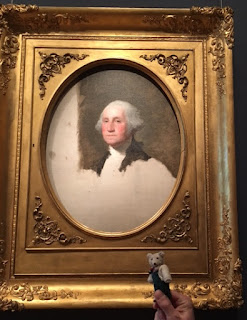Spring has hit with full force here in New England, with new flower surprises appearing daily on front yards, in parks, and around other outdoor spaces. In the Boston area, The Museum of Fine Arts celebrates this time of year with its annual "Art in Bloom" event, which pairs collection highlights with floral arrangements designed to coordinate with the theme of the pieces. Steiffgal took Bitty Bub, a Steiff inspired tiny Teddy baby doll made by the talented artist Elizabeth Leggat, along with her to see "Art in Bloom" and to tour the museum. Of course Bub, known for his mischief, thought the show was called "Art With Bub." As such, he decided to "participate" in the exhibits, as only he can. Here are some of his favorite works - flower related and other - from his visit to the museum today. Can you find him in each of the photos that follow? You can click on them to make them bigger!
Being cut from the finest cloth himself, Bub found this floral arrangement inspired by an original Frank Lloyd Wright textile particularly appealing.
Bub sez, "I'm tickled pink to be part of this fine gallery room display!"
Bub's just one of the guys when it comes to this perfect pairing of Max Beckmann's painting of Perry T. Rathbone with a tall, dark, and handsome floral arrangement.
Bub sez, "The flower artists really put the pedal to the metal in this colorful arrangement celebrating this great painting by Frida Kahlo."
Size defies when it comes to these monumental blue and white Japanese vases that are featured in John Singer Sargent's "The Daughters of Edward Darley Boit," also shown in the photo.
Bub is certain that this fine arts patron from Mary Cassatt's "In the Loge" only has eyes for him.
Bub basks in the glow of this sterling portrait of silversmith and patriot Paul Revere, painted by John Singleton Copley in the 1768-70 timeframe.
Bub sez, "There's plenty of extra room in that painting for me!" in regards to this 1796 portrait of President George Washington by Gilbert Stuart.
Bub sez, "It's five o'clock somewhere!" to toast this elegant and period sterling silver cocktail tray, martini shaker, and goblets interpreted in flowers.
Honestly, did you know that Bub has White House connections? This small bronze statue was made from Daniel Chester French's original plaster cast of the seated Abraham Lincoln, which served as the scale model for the larger than life marble version at the Lincoln Memorial in Washington, DC.
Drama... this marble statue called "Meg Merrilies" by Edward Thaxter tried to kidnap Bub! Mischief attracts mischief for sure!
And finally, if this tour has tuckered you out, that's completely understandable. Here Bub sleepily eyes a c. 1800-30 English Regency bed detailed with two greyhound dogs! Its complementary floral arrangement does a great job in capturing its form in exotic greenery.
Steiffgal - and Bitty Bub - hope this tour of Boston's MFA has helped to make your day even more beautiful!
Have a question about one of your Steiff treasures? Let's talk! Click here to learn more!
































